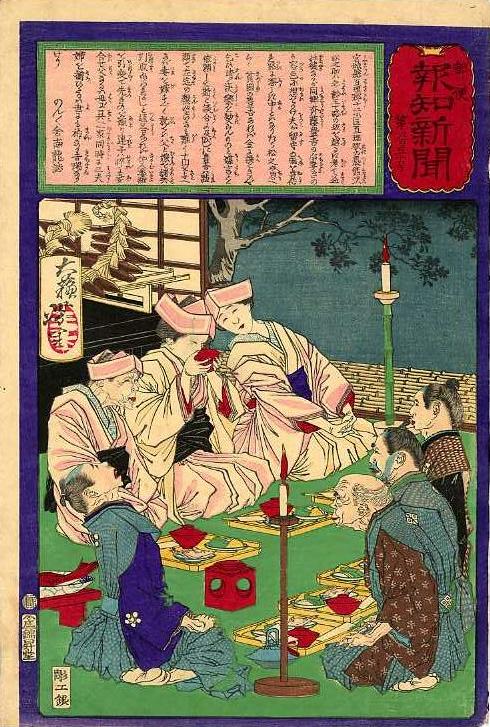No. 650 -- 1875-4-25 Three generations marry Story translationKumazawa Matsunosuke, a farmer, of 12 Shoku Watari station in Watari district of Miyagi prefecture, though surmounting the hill of the road to 50 years of age, was getting healthier as he grew older, and had set his heart on the charms of Kino, the later wife of Saito Toyokichi of the same village. When her husband was away he visited her, and in time they came to be on very deep terms. Matsunosuke, thinking that as Toyokichi was poor he would ask for Kino in exchange for money and openly avow the pleasures [of a husband-wife bond], engaged a stand-between, and when [the mediator] thus talked with [him] Toyokichi nodded. Unable to decline such an entreaty [Toyokichij] replied that were [Matsunosuke] to give him ten yen he could make his wife his bride, but he would also have to take her father and daughter, one and all, and form [bonds for them]. The go-between took care of the particulars. First [Matsunosuke] took Kino as his woman, then her accompanying daughter was married to his son, and her father was given to his mother. That three husbands-and-wives were brought together in one family at the same time was an auspicious omen that is rare in this world. By Nonnonsha Nanryu [Translated by William Wetherall] Commentary (Andon 80)The three-generation marriage story was widely circulated. The version told on this nishikie was based on an article in the 25 April 1875 edition of Hōchi. The story was also reported in the 6 May 1875 edition of Tōnichi (No. 1005). The Tōnichi article inspired another news nishikie version, Ōsaka shinbun nishikiga (Osaka news nishikie) No. 9, which attributes the story to "Nichinichi No. 1500" [sic]. The newspaper articles state that Matsunosuke had lost his wife the previous year. His mother was over 60 and not able to do all the cooking, and his son was 20. Toyokichi, a neighbouring farmer, was over 50 and poor, and Kino, his second wife, was still young. When they married, she had brought with her a daughter by her previous husband, and soon her father had also come to live with them. The Tōnichi article said that Matsunosuke had to pawn his rice paddies to raise the money. The two men exchanged statements in writing. People sighed with grief when the parents, children, and grandchildren married at the same time. The Osaka nishikie version concluded on a note that suggested why the witnesses sighed. After hearing repetitions of Takasago, a popular wedding song from the nō play by this name, they had to watch the san-san-ku-do (three-three-nine-times) ceremony, in which each spouse-to-be takes three sips of sake from each of three cups. [Commentary from Wetherall and Schreiber 2006 in Andon 80] |
Print information
Series: Yubin hochi shinbun
Number: 650
Source: Hochi No. 650 (1875-4-25)
Date: 1875-8 (seal)
Publisher: Kinshodo
Drawer: Taiso Yoshitoshi
Carver: Horiko Gin
Writer: Nonnonsha Nanryu
Size: Oban
Image: Yosha Bunko
Principal sources
Yosha Bunko
Ono 1972:173-174 (Plate 100)
Tsuchiya 2000
